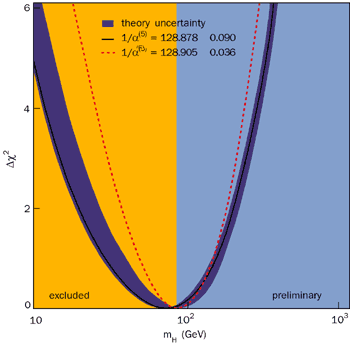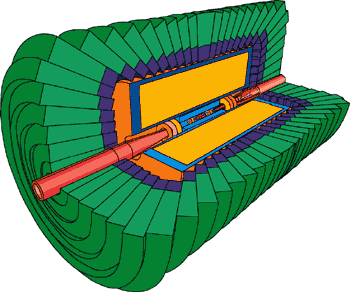While CERN’s LHC proton collider is the world’s major particle physics project, other avenues of research could yield complementary studies. Here, David Miller looks at the possibilities for a linear electron-positron collider.

Competition is the lifeblood of science. We see this at every level. Just now there is intense competition between experiments at the Tevatron at Fermilab and those at LEP at CERN to make the most precise measurement of the mass of the W boson. On many other topics one or other of the two machines is the clear leader: only the Tevatron can make real top quarks, for instance, while only LEP can determine the couplings of the W and the Z bosons to a precision of a few parts per thousand.
CERN’s next machine, the Large Hadron Collider (LHC), will collide protons at 14 TeV, an energy seven times as high as the Tevatron will ever reach, and at a much higher rate. The world’s particle physicists agree that it is the right machine to build next, but it is surely not going to be the only future machine. There is a growing consensus that its competition must come from a linear electron-positron collider with an energy range from the topantitop quark threshold (350 GeV) to somewhere near 1 TeV. Who will build it, and where, is another fascinating competition that will not be decided for a few more years. However, wherever it is built, there is a growing community of would-be users pushing for it.
Taking the Standard Model of particle physics at face value, recent fits to the precision data from LEP, Stanford’s SLC and Fermilab show that the Higgs boson mass should be less than 300 GeV, within the reach of both the LHC and of a 500 GeV linear collider.
Higgs boson
To see a real Higgs boson will be a great achievement, but we will immediately have to ask whether it has the properties predicted by the Standard Model. We expect a “light” Higgs (lighter than 140 GeV) to decay into photonphoton or into beauty quark-antiquark pairs. If it is heavier it should decay into pairs of W bosons, Z bosons or top quark and antiquark. The LHC would surely get into this region first, but it would not be able to measure some of the most basic Higgs properties, for instance its decay width related to its lifetime by the Heisenberg principle.
A linear collider would be needed to do that, either producing the Higgs boson through its direct coupling to W bosons or, for a very light Higgs, by making Higgs bosons in real photon-photon collisions. A high-luminosity linear collider would also be needed to measure the coupling of the Higgs boson to the top quark.
In theories beyond the Standard Model there could be more than one Higgs boson. Minimal supersymmetric models need five, together with the supersymmetric partners of the Standard Model particles.
The precision of the linear collider would be essential in identifying the supersymmetric partner particles of the non-quark/gluon particles (those not carrying the interquark colour force) and making precise measurements of their masses. As its colliding protons contain quarks interacting through the colour force, the LHC will be better for identifying the partners of the quarks and gluons.
Between them the LHC and the linear collider should also be able to check whether the behaviour of the lightest supersymmetric particle is consistent with its being the main constituent of the missing “dark matter” that astrophysics requires to explain the observed large-scale gravitational attractions.
As well as venturing into new physics, the linear collider should also make much improved measurements on the workings of established theory. Its energy can be scanned very carefully across the production threshold of top quarkantiquark pairs. Quantum chromodynamics (QCD), the theory of quarks and gluons, makes very specific predictions for what happens at this threshold, and it should be possible to measure the top quark mass (near 175 GeV) to better than 175 MeV much more precisely than the LHC. The top quark mass will then be proportionally far better known than that of any of the lighter quarks.
At a high-luminosity linear collider, the samples of light quarkantiquark events will match those from LEP1 and offer a chance to probe the evolution of QCD to higher energy scales.If real photon beams can be produced, then the linear collider will also probe the structure of the photon with the same sensitivity that is being achieved for the proton at the HERA electron-proton collider at DESY, Hamburg, thereby testing more of the predictions of QCD.
Even if there is no Higgs boson and if supersymmetry does not appear, some new physics must still happen at the 1 TeV energy scale. There is no precise theory of what this new physics might be, but it would very likely increase the production of top quark-antiquark pairs and of W and Z boson pairs.

Again, the LHC would see something, but it will take a lepton (non-quark) machine with collision energy in the 24 TeV region to sort out the full theory. This could be either a higher energy linear electronpositron collider or a muon collider. However, before then the linear collider in the 500 GeV 1 TeV range should have seen the first signs of the new physics through increasing the precision of studies of W and Z couplings, already testing the Standard Model so stringently at LEP’s 192 GeV.
To do the physics, the detectors at the linear collider will have to be better than those at LEP or the SLC. At higher energies there will be more and narrower jets of particles that have to be kept separate, so the calorimeters that measure the directions of energy flow will need to be finer-grained. It will be particularly important to measure the pairs of electrons or muons from Z decays to see a recoiling Higgs boson in annihilations producing a Higgs and a Z. This requires a good particle tracker to measure the momentum from the curvature of the outgoing electrons or muons.
In European studies, the tracker of choice has been a Time Projection Chamber, like that in ALEPH or DELPHI at LEP, with much higher performance and a 3 Tesla magnetic field. Alternatively, in a 1996 study at Snowmass, the North Americans considered an all-silicon tracker like that planned for the ATLAS experiment at the LHC with a magnetic field of 4 Tesla. The first tracker design from Japan used a large “jet” drift chamber, similar to those in OPAL, or L3 at LEP and SLD at Stanford. Work has already begun on new inner (vertex) detector techniques for the linear collider, using charge-coupled devices or “smart pixels”.
The biggest differences between the detectors for the linear collider and those at LEP will be in the forward directions, close to the colliding beams. The beams meeting head-on at a linear collider have to be compressed into tiny “rods” (with a cross section of around 10 x 500 nm almost molecular proportions compared with tens of microns at LEP) so that the collision rate (luminosity) produces useful numbers of events. Each bunch in the beam contains some 1010 electrons or positrons travelling at close to the speed of light, and producing very strong electric and magnetic fields.

The new physics will emerge from individual high-energy electrons and positrons colliding, but, while these clean events are happening, the two beams will be interacting in other “dirty” ways deflecting and disrupting one another, and producing background radiation when particles in one beam scatter on the electromagnetic fields from the other.
To keep this radiation away from the tracking detectors, thick conical tungsten “masks” will be fitted in the forward regions. These will prevent precise measurements on small angle tracks, though it is hoped to develop techniques (perhaps with quartz fibres buried in the tungsten to produce detectable pulses of light when particles pass through) so that at least it will be known whether any tracks from an interesting event went into a mask.
Significant detector R&D will be needed, but there is no doubt that the experimental environment will be easier than at the LHC, with fewer background events and less radiation hitting the detectors. If the collider can be funded and built then the physics can be done. And although many of the goals are complementary to those of the LHC, there will be real competition too.





